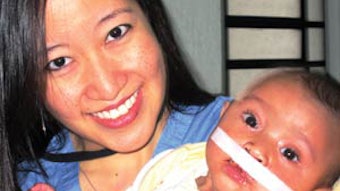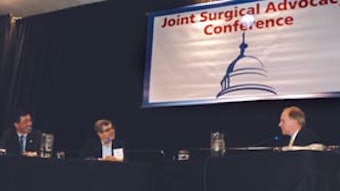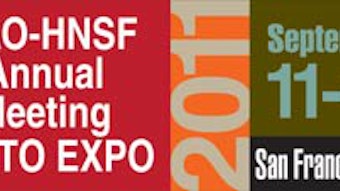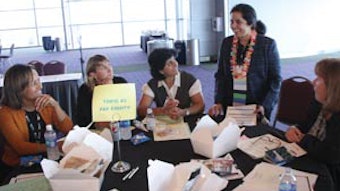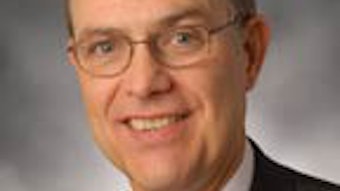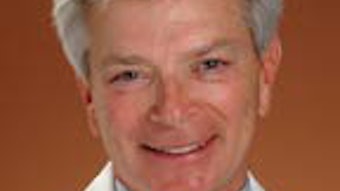BOG Spring Meeting: What You Missed
Over the March 26 weekend, a large and dedicated group of BOG members and related organizations descended on Alexandria, VA, and Washington, DC, to take part in the Board of Governors (BOG) Annual Spring Meeting and the Joint Surgical Advocacy Conference (JSAC). The event started with an “ice breaker,” in which we considered each of our individual strengths in the four domains of leadership critical for success: execution, influence, relationship building, and strategic thinking. The BOG Socioeconomics and Grassroots Committee, under the guidance of Denis C. Lafreniere, MD, and Steven B. Levine, MD, led us through a packed agenda beginning with an overview of maintenance of certification by Robert H. Miller, MD, MBA. John R. Houck, Jr., MD, led a discussion of “Bundling Practices, “followed by Brian J. Broker, MD, who presented “Fragmentation of the Otolaryngologist.” The discussion was engaging and lively. Susan R. Cordes, MD, BOG member-at-large, led a panel discussion on how state societies can best share the message of their specific state and Academy activities. This went a long way to answer the question: “What has the Academy done for me lately?” It amazes me that the wonderful work done by the Academy, including the grassroots efforts of our members and your BOG, are not well-known by our membership, despite multimodal strategies to disseminate that information via the Bulletin, emails, tweets, and more. Please don’t hit the “delete” button so quickly on the emails. I am pleased to report that for “card-carrying” members of the AAO-HNS, your $820 dues has a calculable return on investment of about $12,000 to $15,000 secured by coding changes, unbundling, and other efforts made by your leadership and staff at the AAO-HNS. Also, we need to consider supporting the non-partisan ENT PAC*, the Academy’s political action committee. Ninety-plus percent of trial lawyers contribute to their respective PACs, but only 11 percent of us contributed to ENT PAC last year. While many of our PAC donors give $365 or more, any contribution will help us expand the strength of ENT PAC. The more members we have, the greater our leverage on Capitol Hill. The Development/Fundraising Task Force led by Jay S. Youngerman, MD, presented the ongoing outstanding philanthropic initiative; the Hal Foster, MD, Endowment Society has nearly $5 million pledged and is well on the way to its $30 million goal. If you have not yet considered the concept of a legacy (or any other form) gift to the Foundation, please join the Millennium Society and support important activities of the AAO-HNSF. During the Legislative Representatives meeting spearheaded by Paul Imber, DO, and Stacey L. Ishman, MD, we heard about ways to get more involved in state and federal legislative activities. A true highlight was hearing Rep. Tom Price, MD, R-GA, speak to us about opportunities for success in healthcare reform. He advised each of us to “befriend” one or two of our representatives by sending emails, making calls, and supporting them locally. The more they see your face and hear your name, the more likely they are to use you as a valuable resource for promoting our agenda of great healthcare for all. Sujana S. Chandrasekhar, MD, BOG chair-elect, led a discussion about incorporating mid-level providers (MLPs) into your practice. To be ready for the increasing number of patients who will have access to our care, we need to train these providers to work in our offices as “physician extenders.” The following day opened with the Keynote Address from Gail Warden, past CEO of Henry Ford Health System, who has chaired numerous committees at the Institute of Medicine. He is the chairman emeritus of the National Quality Forum, the National Committee for Quality Assurance, a past chair of the American Hospital Association, and currently serves as an advisor on the RAND Health Board. He also has advised the past two U.S. presidents, as well as President Barack Obama on healthcare reform. The President also asked him to serve on the Independent Payment Advisory Board (IPAB), but he declined. It was indeed an honor to learn from him about ways to positively affect healthcare reform for our patients and the future of our practices. We segued to JSAC, and once again otolaryngologists were the second largest represented group of surgeons in attendance. Congratulations to those of you who helped spread our message. This was a wonderful opportunity to talk about our concerns regarding the IPAB and the Sustainable Growth Rate, medical liability reform, healthcare truth-in-advertising legislation, and quality improvement initiatives. We will meet again at the Annual Meeting in San Francisco, and we have an outstanding miniseminar, “Hot Topics in Otolaryngology: 2011,” planned by Peter Abramson, MD, BOG secretary, on Tuesday, September 13. I am here to serve. Please contact me with any questions or comments mseidma1@hfhs.org. * Contributions to ENT PAC are not deductible as charitable contributions for federal income tax purposes. Contributions are voluntary, and all members of the American Academy of Otolaryngology-Head and Neck Surgery have the right to refuse to contribute without reprisal. Federal law prohibits ENT PAC from accepting contributions from foreign nationals. By law, if your contributions are made using a personal check or credit card, ENT PAC may use your contribution only to support candidates in federal elections. All corporate contributions to ENT PAC will be used for educational and administrative fees of ENT PAC, and other activities permissible under federal law. Federal law requires ENT PAC to use its best efforts to collect and report the name, mailing address, occupation, and the name of the employer of individuals whose contributions exceed $200 in a calendar year.
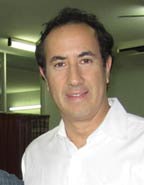 Michael D. Seidman, MD, Chair, Board of Governors
Michael D. Seidman, MD, Chair, Board of GovernorsOver the March 26 weekend, a large and dedicated group of BOG members and related organizations descended on Alexandria, VA, and Washington, DC, to take part in the Board of Governors (BOG) Annual Spring Meeting and the Joint Surgical Advocacy Conference (JSAC). The event started with an “ice breaker,” in which we considered each of our individual strengths in the four domains of leadership critical for success: execution, influence, relationship building, and strategic thinking.
The BOG Socioeconomics and Grassroots Committee, under the guidance of Denis C. Lafreniere, MD, and Steven B. Levine, MD, led us through a packed agenda beginning with an overview of maintenance of certification by Robert H. Miller, MD, MBA. John R. Houck, Jr., MD, led a discussion of “Bundling Practices, “followed by Brian J. Broker, MD, who presented “Fragmentation of the Otolaryngologist.” The discussion was engaging and lively.
Susan R. Cordes, MD, BOG member-at-large, led a panel discussion on how state societies can best share the message of their specific state and Academy activities. This went a long way to answer the question: “What has the Academy done for me lately?” It amazes me that the wonderful work done by the Academy, including the grassroots efforts of our members and your BOG, are not well-known by our membership, despite multimodal strategies to disseminate that information via the Bulletin, emails, tweets, and more. Please don’t hit the “delete” button so quickly on the emails.
I am pleased to report that for “card-carrying” members of the AAO-HNS, your $820 dues has a calculable return on investment of about $12,000 to $15,000 secured by coding changes, unbundling, and other efforts made by your leadership and staff at the AAO-HNS. Also, we need to consider supporting the non-partisan ENT PAC*, the Academy’s political action committee. Ninety-plus percent of trial lawyers contribute to their respective PACs, but only 11 percent of us contributed to ENT PAC last year. While many of our PAC donors give $365 or more, any contribution will help us expand the strength of ENT PAC. The more members we have, the greater our leverage on Capitol Hill.
The Development/Fundraising Task Force led by Jay S. Youngerman, MD, presented the ongoing outstanding philanthropic initiative; the Hal Foster, MD, Endowment Society has nearly $5 million pledged and is well on the way to its $30 million goal. If you have not yet considered the concept of a legacy (or any other form) gift to the Foundation, please join the Millennium Society and support important activities of the AAO-HNSF.
During the Legislative Representatives meeting spearheaded by Paul Imber, DO, and Stacey L. Ishman, MD, we heard about ways to get more involved in state and federal legislative activities. A true highlight was hearing Rep. Tom Price, MD, R-GA, speak to us about opportunities for success in healthcare reform. He advised each of us to “befriend” one or two of our representatives by sending emails, making calls, and supporting them locally. The more they see your face and hear your name, the more likely they are to use you as a valuable resource for promoting our agenda of great healthcare for all.
Sujana S. Chandrasekhar, MD, BOG chair-elect, led a discussion about incorporating mid-level providers (MLPs) into your practice. To be ready for the increasing number of patients who will have access to our care, we need to train these providers to work in our offices as “physician extenders.”
The following day opened with the Keynote Address from Gail Warden, past CEO of Henry Ford Health System, who has chaired numerous committees at the Institute of Medicine. He is the chairman emeritus of the National Quality Forum, the National Committee for Quality Assurance, a past chair of the American Hospital Association, and currently serves as an advisor on the RAND Health Board. He also has advised the past two U.S. presidents, as well as President Barack Obama on healthcare reform. The President also asked him to serve on the Independent Payment Advisory Board (IPAB), but he declined. It was indeed an honor to learn from him about ways to positively affect healthcare reform for our patients and the future of our practices.
We segued to JSAC, and once again otolaryngologists were the second largest represented group of surgeons in attendance. Congratulations to those of you who helped spread our message. This was a wonderful opportunity to talk about our concerns regarding the IPAB and the Sustainable Growth Rate, medical liability reform, healthcare truth-in-advertising legislation, and quality improvement initiatives.
We will meet again at the Annual Meeting in San Francisco, and we have an outstanding miniseminar, “Hot Topics in Otolaryngology: 2011,” planned by Peter Abramson, MD, BOG secretary, on Tuesday, September 13.
I am here to serve. Please contact me with any questions or comments mseidma1@hfhs.org.
* Contributions to ENT PAC are not deductible as charitable contributions for federal income tax purposes. Contributions are voluntary, and all members of the American Academy of Otolaryngology-Head and Neck Surgery have the right to refuse to contribute without reprisal. Federal law prohibits ENT PAC from accepting contributions from foreign nationals. By law, if your contributions are made using a personal check or credit card, ENT PAC may use your contribution only to support candidates in federal elections. All corporate contributions to ENT PAC will be used for educational and administrative fees of ENT PAC, and other activities permissible under federal law. Federal law requires ENT PAC to use its best efforts to collect and report the name, mailing address, occupation, and the name of the employer of individuals whose contributions exceed $200 in a calendar year.
